Image Segmentation by Clustering: A Detailed Overview
Table of Contents
- What is Image Segmentation?
- What is Clustering in Image Segmentation?
- Image Segmentation by Clustering
- Types of Image Segmentation Techniques
- Use of Image Segmentation in Image Processing
- Practical Applications of Image Segmentation by Clustering
- Practical Code Examples
- Hierarchical Clustering in Image Segmentation
- Comparison Between K-Means Clustering and Hierarchical Clustering
- Practical Applications of Image Segmentation by Clustering
- 10.1 Medical Imaging
- 10.2 Autonomous Driving
- 10.3 Satellite Image Analysis
- 10.4 Content-Based Image Retrieval
- Conclusion
- Acknowledgements
1. What is Image Segmentation?
Image segmentation divides an image into meaningful segments to make it easier to analyze. These segments represent areas such as objects or boundaries.
Subcategories of Image Segmentation:
- Semantic Segmentation: Labels each pixel based on its class (e.g., road, car) but doesn’t differentiate between instances of the same class.
- Instance Segmentation: Identifies and segments distinct instances of the same class (e.g., two cars).
- Panoptic Segmentation: Combines both semantic and instance segmentation for detailed analysis.
2. What is Clustering in Image Segmentation?
Clustering groups similar pixels together based on features like color or intensity. It’s an unsupervised technique used to segment images without labeled data.
Popular Clustering Algorithms:
- K-Means Clustering: Groups pixels into k clusters based on color/intensity.
- Mean Shift Clustering: Finds modes in feature space for segmentation.
- DBSCAN: Groups pixels by density, useful for irregular clusters.
3. Image Segmentation by Clustering
This method uses clustering algorithms to group pixels based on their similarities, creating segments of the image.
Process:
- Feature Extraction: Identifying differentiating features like color or texture.
- Clustering: Apply algorithms like K-Means.
- Segment Creation: Assign pixels to segments based on clustering.
- Post-Processing: Refine segments for improved boundary accuracy.
Advantages:
- Unsupervised: No labeled data needed.
- Versatile: Works across various feature spaces (e.g., RGB, HSV).
- Scalable: Suitable for large images.
4. Types of Image Segmentation Techniques
A. Semantic Segmentation
Assigns a class label to every pixel. Used for general categorization (e.g., land, sky).
- Applications: Medical imaging, geospatial analysis, autonomous vehicles.
B. Instance Segmentation
Identifies and segments distinct objects within the same category.
- Applications: Tumor detection, robotics, autonomous vehicles.
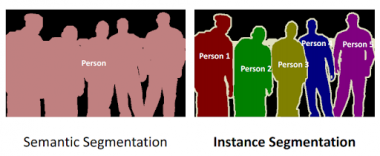 image-source: google
image-source: google
5. Use of Image Segmentation in Image Processing
Image segmentation enhances image analysis by isolating regions of interest, helping with tasks like object detection, feature enhancement, and image compression.
6. Practical Applications of Image Segmentation by Clustering
- Medical Imaging: Segment anatomical structures in scans (e.g., MRI, CT).
- Satellite Image Analysis: Classify land cover (e.g., water, urban areas).
- Object Tracking in Videos: Separate foreground and background in video sequences.
- Image Compression: Simplify images by segmenting into regions and reducing data.
7. Practical Code Examples
7.1 K-means Clustering (k=3)
Performs image segmentation with 3 clusters.
Segmentation for k = 3
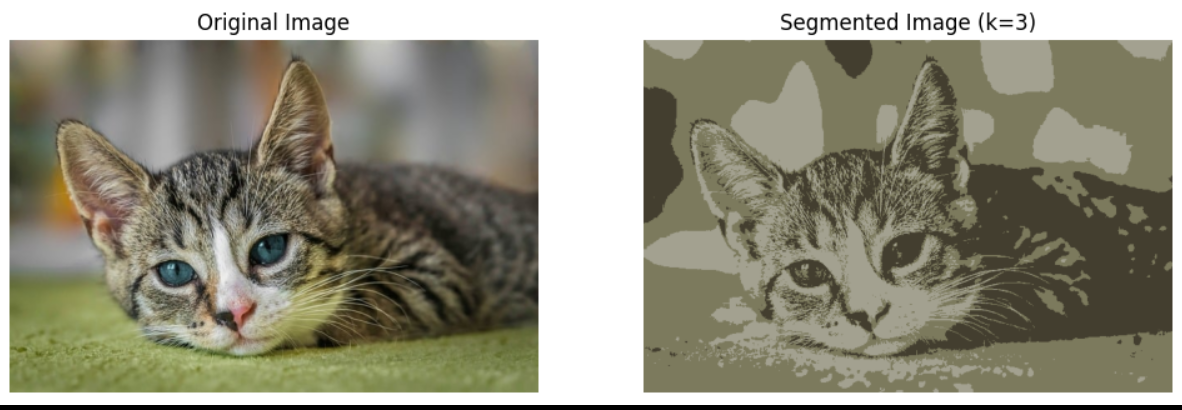
- Process: Reads and reshapes the image, applies K-means clustering.
- Applications: Segmentation of foreground and background.
7.2 K-means Clustering (k=2)
Similar to the previous method but segments the image into 2 clusters.
7.3 Elbow Method for Optimal k
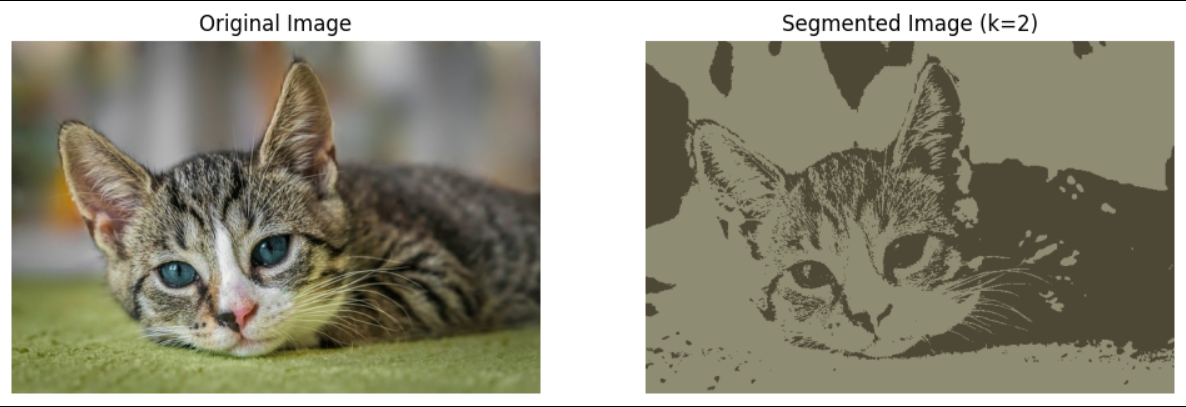
- Applications: Binary segmentation (e.g., separating sky from ground).
7.4 Preprocessing and K-means Clustering with Grayscale Image
The Elbow Method is used to determine the optimal number of clusters (k) for segmentation.
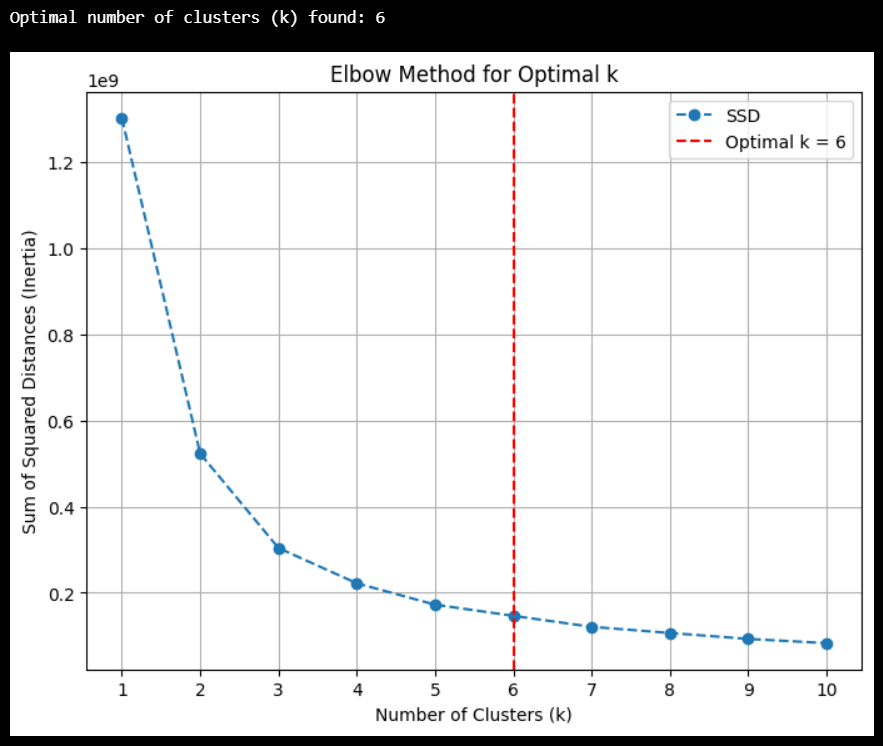
-
Process:
- The sum of squared distances (SSD) between points and their assigned cluster centroid is calculated for different values of k.
- As k increases, SSD typically decreases. However, at some point, the improvement in SSD slows down, forming an "elbow" in the graph.
- The optimal k is typically chosen at the point where the SSD curve forms a sharp bend (the "elbow").
Steps in the Elbow Method:
- Start with a small value of k (e.g., k=1).
- Calculate the SSD (or Within-Cluster Sum of Squares).
- Increase k and repeat the SSD calculation.
- Plot SSD against k and look for the "elbow" point.
-
Applications: The Elbow Method helps in choosing the ideal k value automatically, which can improve segmentation accuracy.
Optimal k Value Determination
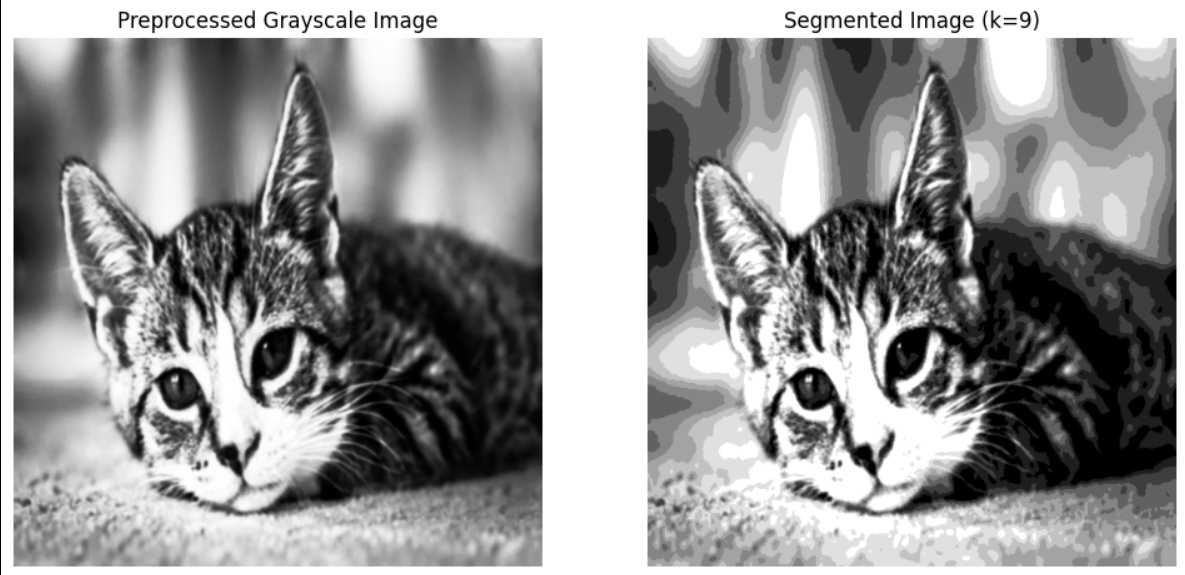
4. Preprocessing and K-means Clustering with Grayscale Image
Preprocesses image with resizing, blurring, and equalization before clustering.
- Applications: Tumor detection in medical images.
8. Hierarchical Clustering in Image Segmentation
Hierarchical clustering is a technique used to group similar objects into clusters. It is particularly effective in image segmentation tasks as it creates a tree-like structure (dendrogram) that represents the relationships between different data points. There are two main approaches to hierarchical clustering:
8.1 Agglomerative Clustering (Bottom-Up Approach)
This approach starts with each pixel as its own cluster and iteratively merges the closest clusters based on a specified distance metric.
8.2 Divisive Clustering (Top-Down Approach)
In contrast, divisive clustering begins with all data points in one cluster and iteratively splits them into smaller clusters.
Steps to Implement Hierarchical Clustering for Image Segmentation
Load and Preprocess the Image:
Resize the image:
Reduce the image size to speed up the processing time.
Flatten the image: Convert the image from a 3D matrix (height, width, channels) to a 2D array where each row represents a pixel and columns represent the color channels (e.g., RGB values).
Perform Feature Normalization:
Scale the features:
Normalize the pixel values (or other features such as texture or intensity) to a range of [0, 1] to make clustering more effective and prevent bias due to varying feature ranges.
Apply Hierarchical Clustering:
Use libraries like scipy.cluster.hierarchy to compute the linkage matrix. The linkage matrix determines how the clusters are formed based on the selected linkage criterion.
Common linkage criteria:
Single Linkage:
Defines the distance between two clusters as the minimum distance between any two points from different clusters.
Complete Linkage: Defines the distance as the maximum distance between any two points from different clusters.
Average Linkage: Uses the mean distance between points in different clusters.
Cut the Dendrogram:
Once the hierarchical clustering dendrogram is formed, you need to determine the number of clusters, k. This is done by cutting the dendrogram at a specified height or threshold. This decides where the clusters should be divided.
Visualize the Results:
Reshape the clustered labels back to the original image shape.
Display the segmented image where each cluster is represented by a unique color.
Practical Code Example:
The following steps outline the code implementation for hierarchical clustering in image segmentation.
Divisive Clustering (Top-Down Approach)
In divisive clustering, the image is first considered as one large cluster and is divided iteratively. This approach can be more computationally intensive and less commonly used but is ideal for certain types of image segmentation tasks.

Agglomerative Clustering (Bottom-Up Approach)
Agglomerative clustering, being more widely used, starts with each pixel as its own cluster and merges them based on their proximity. This method is usually more computationally efficient and easier to implement for image segmentation.

Conclusion
Hierarchical clustering is a versatile and powerful tool for image segmentation. By choosing the appropriate linkage criteria and threshold for cutting the dendrogram, you can effectively group pixels into distinct regions based on their color and texture features. Whether you use the divisive or agglomerative method depends on the specific requirements of your image segmentation task.
9. Comparison Between K-Means Clustering and Hierarchical Clustering
| Feature | K-Means Clustering | Hierarchical Clustering |
|---|---|---|
| Clustering Type | Partitional (divides data into k clusters) | Agglomerative (bottom-up) or Divisive (top-down) |
| Number of Clusters | Predefined (you must specify k before running) | Not predefined (can be decided by cutting the dendrogram) |
| Cluster Shape | Typically circular or spherical | Can form arbitrary shapes depending on the data |
| Scalability | Efficient for large datasets (O(n * k * d)) | Computationally expensive, especially for large datasets |
| Sensitivity to Initial Centroids | Sensitive to initial random centroid placement | Not sensitive to initial cluster configuration |
| Speed | Faster, suitable for large datasets | Slower, especially for large datasets |
| Distance Measure | Euclidean distance (typically) | Can use different distance measures (Euclidean, Manhattan, etc.) |
| Output | K clusters (fixed) | Dendrogram (tree structure), can cut at any level |
| Interpretability | Easy to interpret clusters, good for well-separated data | More complex due to dendrogram, flexible in terms of cluster formation |
| Use Cases | Well-suited for large datasets with a known number of clusters | Ideal for smaller datasets or when the number of clusters is not known |
| Handling Noise/Outliers | Sensitive to noise and outliers | More robust to outliers (depending on linkage criteria) |
| Examples of Usage | Image compression, market segmentation, document clustering | Gene expression data, hierarchical classification, dendrogram visualization |
10. Practical Applications of Image Segmentation by Clustering
10.1 Medical Imaging
Segment anatomical structures in MRI/CT scans for accurate diagnosis.
10.2 Autonomous Driving
Detect and classify road signs, vehicles, and pedestrians.
10.3 Satellite Image Analysis
Classify regions such as water bodies, forests, and urban areas.
10.4 Content-Based Image Retrieval
Enhance search accuracy by segmenting images based on content.
11. Conclusion
Hierarchical and K-means clustering are effective methods for image segmentation. Choosing the right algorithm depends on the image characteristics and computational resources.
12. Acknowledgements
Under the guidance of Dr. Agughasi Victor Ikechukwu (GitHub Profile)